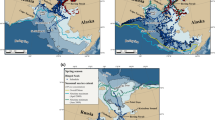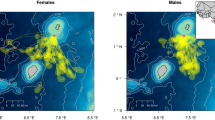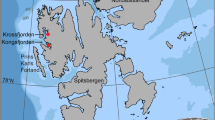Abstract
The harp seal Pagophilus groenlandicus is a major high trophic level predator in the Barents Sea, and to better understand their function in the Barents Sea ecosystem, we need to understand their foraging behaviour during their most intensive feeding period. We analysed the diet composition and prey preference of 184 harp seals and 94 faeces samples, sampled in the northern Barents Sea (around Svalbard) during the period May–August in 1996, 1997, and 2004–2006. Concurrent with the sampling of seals, prey availability was assessed in one area in 1996 and 1997 and in two areas in 2006 using standard acoustic methods. Our study showed that harp seal diet composition varied significantly both in time (year) and space, and that their diets appeared to be size dependent. Both subadult (<150 cm) and adult seals were associated with pelagic crustaceans (particularly krill), whereas primarily adult seals were associated with fish (capelin, gadoids and flatfish). Krill was the most important prey group (63 %) followed by polar cod (16 %) and other fish species (10 %). The prey preference of harp seals varied in time and space; polar cod was often preferred by the seals whereas krill was commonly consumed in lower proportion than observed in the survey area. Gadoids and capelin had either been exploited in the same or less proportion as observed in the survey sea. This study emphasises the ecological significance of krill as prime food for harp seals during their intensive feeding period in summer.






Similar content being viewed by others
References
Abrams PA, Ginzburg LR (2000) The nature of predation: prey dependent, ratio dependent or neither? TREE 15:337–341
Barrett R, Anker-Nilssen T, Gabrielsen GW, Chapdelaine G (2002) Food consumption by seabirds in Norwegian waters. ICES J Mar Sci 59:43–57
Bodholt H, Nes H, Solli H (1989) A new echo-sounder system. Proc Inst Acoust 11:123–130
Bogstad B, Hauge KH, Ulltang Ø (1997) MULTSPEC—a multispecies model for fish and marine mammals in the Barents Sea. J Northw Atl Fish Sci 22:317–341
Bogstad B, Haug T, Mehl S (2000) Who eats whom in the Barents Sea. NAMMCO Sci Publ 2:98–119
Bowen WD, Tully D, Boness DJ, Bulheier BM, Marshall GJ (2002) Prey-dependent foraging tactics and prey profitability in a marine mammal. Mar Ecol Prog Ser 244:235–245
Bradstreet M, Cross W (1982) Trophic relationships at high arctic ice edges. Arctic 35:1–12
Breiby A (1985) Otolitter fra saltvannsfisker i Nord Norge. Tromura Naturvitenskap 53:1–30
Chapskii KK (1961) Nektorye ekologicheskie obosnovanniia sezonnoj dynamiki areala belomorskoj populjatsii grenlandskogo tjulerja (Pagophilus groenlandica) (Some biological factors determining seasonal changes in distribution of the White Sea harp seal population). Trudy Soveschanija, Ichtiologicheskoi Komissii Akademii Nauk. SSSR 12:150–163 (Fisheries Research Board of Canada, Translation Series, 380:1–22)
Charnov E (1976) Optimal foraging: the marginal value theorem. Theor Pop Biol 9:129–136
Chesson J (1978) Measuring preference in selective predation. Ecology 59:211–215
Cressie NAC (1993) Statistics for spatial data. Wiley, New York, p 900
Dalpadado P, Skjoldal HR (1996) Abundance, maturity and growth of krill species Thysanoessa inermis and T. longicaudata in the Barents Sea. Mar Ecol Prog Ser 144:175–183
Dommasnes A, Christensen V, Ellertsen B, Kvamme C, Melle W, Nøttestad L, Pedersen T, Tjelmeland S, Zeller D (2001) An Ecopath model for the Norwegian and Barents Sea. In: Guénette S, Christensen V, Pauly D (eds) Fisheries impacts on North Atlantic ecosystems: models and analyses. Fish Centre Res Rep 9(4):213–240
Efron B, Tibshirani RJ (1993) An introduction to bootstrap. Chapman and Hall, Inc., New York, p 436
Enckell PH (1980) Fältfauna/Kräftdjur. Bokförlaget Sigmun i Lund, pp 685
Eriksen E, Dalpadado P (2011) Long-term changes in Krill biomass and distribution in the Barents Sea: are the changes mainly related to capelin stock size and temperature conditions? Polar Biol 34:1399–1409
Falk-Petersen S, Hopkins CCE, Sargent JR (1990) Trophic relationships in the pelagic, Arctic food web. In: Barnes M, Gibson RN (eds) Trophic relationship in the marine environment. University Press, Aberdeen, pp 315–333
Falk-Petersen S, Haug T, Hop H, Nilssen KT, Wold A (2009) Transfer of lipids from plankton to blubber of harp and hooded seals off East Greenland. Deep Sea Res II 56:2080–2086
Finley KJ, Bradstreet MSW, Miller GW (1990) Summer feeding ecology of harp seals (Phoca groenlandica) in relation to Arctic cod (Boreogadus saida) in the Canadian high Arctic. Polar Biol 10:609–618
Foote KG, Knudsen HP, Korneliussen RJ, Nordbø PE, Røang K (1991) Post processing system for echo sounder data. J Acoust Soc Am 90:37–47
Frie AK, Potelov VA, Kingsley MCS, Haug T (2003) Trends in age at maturity and growth parameters of female northeast Atlantic harp seals, Pagophilus groenlandicus. ICES J Mar Sci 60:1018–1032
Fryxell JM, Lundberg P (1994) Diet choice and predator-prey dynamics. Evol Ecol 8:407–421
Gjøsæter H, Bogstad B (1998) Effects of the presence of herring (Clupea harengus) on the stock–recruitment relationship of Barents Sea capelin (Mallotus villosus). Fish Res 38:57–71
Gjøsæter H, Bogstad B, Tjelmeland S (2009) Ecosystem effects of the three capelin stock collapses in the Barents Sea. Mar Biol Res 5:40–53
Grahl-Nielsen O, Haug T, Lindstrøm U, Nilssen KT (2011) Fatty acids in harp seal blubber do not necessarily reflect their diet. Mar Ecol Prog Ser 426:263–276
Grellier K, Hammond PS (2006) Robust digestion and passage rate estimates for hard parts of grey seal (Halichoerus grypus) prey. Can J Fish Aquat Sci 63:1982–1998
Hamre J (1994) Biodiversity and exploitation of the main fish stocks in the Norwegian-Barents Sea ecosystem. Biodiv Conserv 3:473–492
Harbitz A, Lindstrøm U (2001) Stochastic spatial analysis of marine resources with application to minke whale foraging: a synoptic case study from the southern Barents. Sarsia 86:485–5010
Härkönen T (1986) Guide to the otoliths of the bony fishes of the northeast Atlantic. Danbiu ApS, Hellerup
Hassel MP, May RM (1974) Aggregation of predators and insect parasites and its effect on stability. J Anim Ecol 43:567–594
Haug T, Nilssen KT, Øien N, Potelov V (1994) Seasonal distribution of harp seals (Phoca groenlandica) in the Barents Sea. Polar Res 13:161–172
Haug T, Lindstrøm U, Nilssen KT (2002) Variations in minke whale (Balaenoptera acutorostrata) diet and body condition in response to ecosystem changes in the Barents Sea. Sarsia 87:409–422
Haug T, Nilssen KT, Lindblom L (2004) Feeding habits of harp and hooded seals in drift ice waters along the east coast of Greenland in summer and winter. Polar Res 23:35–42
Haug T, Nilssen KT, Lindblom L, Lindstrøm U (2007) Diets of hooded seals (Cystophora cristata) in coastal waters and drift ice waters along the east coast of Greenland. Mar Biol Res 3:123–133
Hjermann DØ, Bogstad B, Eikeset AM, Ottersen G, Gjøsæter H, Stenseth NC (2007) Food web dynamics affect Northeast Arctic cod recruitment. Proc R Soc B 274:661–669
ICES (2011a) Report of the Arctic Fisheries Working Group, 28 April–4 May 2011, Hamburg, Germany. ICES CM 2011/ACOM:05
ICES (2011b) Report of the joint ICES/NAFO Working Group on Harp and Hooded Seals. St.Andrews, Scotland, UK, 15–19 August 2011. ICES CM 2011/ACOM:22
Johannesen E, Ingvaldsen RB, Bogstad B, Dalpadado P, Eriksen E, Gjøsæter H, Knutsen T, Skern-Mauritzen M, Stiansen JE (2012) Changes in Barents Sea ecosystem state, 1970–2009: climate fluctuations, human impact, and trophic interactions. ICES J Mar Sci 69:880–889
Kapel FO (2000) Feeding habits of harp and hooded seals in Greenland waters. NAMMCO Sci Publ 2:50–64
Kitandis PK (1997) Introduction to geostatistics: applications to hydrogeology. Cambridge University Press, Cambridge, p 247
Kotler BP, Brown JS (1988) Environmental heterogeneity and coexistence of desert rodents. Annu Rev Ecol Syst 19:281–307
Kotler BP, Brown JS (1999) Mechanisms of coexistence of optimal foragers as determinants of the local abundance and distributions of desert granivores. J Mamm 80:361–374
Lawson JW, Anderson JT, Dalley EL, Stenson GB (1998) Selective foraging by harp seals Phoca groenlandica in nearshore and offshore waters of Newfoundland, 1993 and 1994. Mar Ecol Prog Ser 163:1–10
Legendre P, Anderson MJ (1999) Distance-based redundancy analysis: testing multispecies responses in multifactorial ecological experiments. Ecol Monogr 69:1–24
Legendre P, Legendre L (1998) Numerical ecology, 2nd edn. Elsevier Science, Amsterdam, p 853
Lindstrøm U, Harbitz A, Haug T, Nilssen KT (1998) Do harp seals Phoca groenlandica exhibit particular prey preferences? ICES J Mar Sci 55:941–953
Lindstrøm U, Smouth S, Howell D, Bogstad B (2009) Modelling multi-species interactions in the Barents Sea ecosystem with special emphasis on minke whales and their interactions with cod, herring and capelin. Deep-Sea Res II 56:2068–2079
MacLennan DN, Simmonds EJ (1992) Fisheries acoustics. Chapman & Hall, London, p 325
Mårtensson PE, Nordøy ES, Messelt EB, Blix AS (1998) Gut length, food transit time and diving habit in phocid seals. Polar Biol 20:213–217
Matthiopoulos J, Smout S, Winship AJ, Thompson D, Boyd IL, Harwood J (2008) Getting beneath the surface of marine mammal—fisheries competition. Mammal Rev 38:167–188
Murphy EJ, Morris DJ, Watkins JL, Priddle J (1988) Scales of interaction between Antarctic krill and the environment. In: Sahrhage D (ed) Antarctic Ocean and resources variability. Springer, Berlin, pp 120–130
Nilssen KT (1995) Seasonal distribution, condition and feeding habits of Barents Sea harp seals (Phoca groenlandica). In: Blix AS, Walløe L, Ulltang Ø (eds) Whales, seals, fish and man. Elsevier Science BV, Amsterdam, pp 241–254
Nilssen KT, Haug T, Potelov V, Stasenkov VA, Timoshenko YK (1995a) Food habits of harp seals (Phoca groenlandica) during lactation and moult in March–May in the southern Barents Sea and White Sea. ICES J Mar Sci 52:33–41
Nilssen KT, Haug T, Potelov V, Timoshenko YK (1995b) Food habits and food availability of harp seals (Phoca groenlandica) during early summer and autumn in the northern Barents Sea. Polar Biol 15:485–493
Nilssen KT, Haug T, Grotnes PE, Potelov V (1997) Seasonal variation in body condition of adult Barents Seaharp seals (Phoca groenlandica). J Northw Atl Fish Sci 22:17–25
Nilssen KT, Pedersen OP, Folkow LP, Haug T (2000) Food consumption estimates of Barents Sea harp seals. NAMMCO Sci Publ 2:9–27
Nordøy ES, Folkow LP, Potelov V, Prischemikhin V, Blix AS (2008) Seasonal distribution and dive behaviour of harp seals (Pagophilus groenlandicus) of the White Sea-Barents Sea stock. Polar Biol 31:1119–1135
Øigård TA, Lindstrøm U, Nilssen KT, Haug T (in revision) Functional relationship between harp seal body condition, environment and prey in the Barents Sea. Mar Ecol Prog Ser
Oksanen J (2011) Multivariate analyses of ecological communities in R: vegan tutorial. http://cc.oulu.fi/~jarioksa/opetus/metodi/vegantutor.pdf
Pethon P (1985) Ascheougs store fiskebog. Aschehoug H and company (Nygaard W) A/S, Norway
Piatt JF, Methven DA (1992) Threshold foraging behaviour of baleen whales. Mar Ecol Prog Ser 84:205–210
Potelov V, Nilssen KT, Svetochev V, Haug T (2000) Feeding habits of harp (Phoca groenlandica) and hooded seals (Cystophora cristata) during late winter, spring and early summer in the Greenland Sea. NAMMCO Sci Publ 2:40–49
Rosenzweig ML, MacArthur RH (1963) Graphical representation and stability conditions of predator-prey interactions. Am Nat 97:209–223
Ryg M, Lydersen C, Markusen NH, Smith TG, Øritsland NA (1990) Estimating the blubber content of phocid seals. Can J Fish Aquat Sci 47:1223–1227
Sakshaug E, Bjørge A, Gulliksen B, Loeng H, Mehlum F (1992) Økosystem Barentshavet. Universitetsforlaget, Oslo, p 304
Sergeant D (1973) Feeding, growth, and productivity of northwest Atlantic harp seals (Pagophilus groenlandicus). J Fish Res Board Can 30:17–29
Sih A, Englund G, Wooster D (1998) Emergent impacts of multiple predators on prey. TREE 13:350–355
Skjoldal HR, Hassel A, Rey F (1987) Spring phytoplankton development and zooplankton reproduction in the central Barents Sea in the period 1979–1984. In: Loeng H (ed) The effect of oceanographic conditions on distribution and population dynamics of commercial fish stocks in the Barents Sea. Proceedings of the 3rd Soviet–Norwegian Symposium, IMR/PINRO, Bergen, pp 59–89
ter Braak CJF, Verdonschot PMF (1995) Canonical correspondence analysis and related multivariate methods in aquatic ecology. Aquat Sci 57:255–289
Vincent TLS, Scheel D, Brown JS, Vincent TL (1996) Trade-offs and coexistence in consumer-resource models: it all depends on what and where you eat. Am Nat 148:1038–1058
Wassmann P, Reigstad M, Haug T, Rudels B, Carroll ML, Hop H, Gabrielsen GW, Falk-Petersen S, Denisenko SG, Arashkevich E, Slagstad D, Pavlova O (2006) Food webs and carbon flux in the Barents Sea. Progr Oceanogr 71:232–287
Windsland K, Lindstrøm U, Nilssen KT, Haug T (2007) Relative abundance and size composition of prey in the common minke whale diet in selected areas of the northeast Atlantic during 2000–04. J Cetacean Res Manage 9:167–178
Acknowledgments
The authors thank L. Lindblom, N. E Skavberg and the crew on board M/S Jan Mayen, along with the two reviewers who gave valuable comments to the manuscript. Sophie Smout has kindly proof-read the manuscript.
Author information
Authors and Affiliations
Corresponding author
Electronic supplementary material
Below is the link to the electronic supplementary material.
Appendix
Appendix
See Table 4.
Rights and permissions
About this article
Cite this article
Lindstrøm, U., Nilssen, K.T., Pettersen, L.M.S. et al. Harp seal foraging behaviour during summer around Svalbard in the northern Barents Sea: diet composition and the selection of prey. Polar Biol 36, 305–320 (2013). https://doi.org/10.1007/s00300-012-1260-x
Received:
Revised:
Accepted:
Published:
Issue Date:
DOI: https://doi.org/10.1007/s00300-012-1260-x




